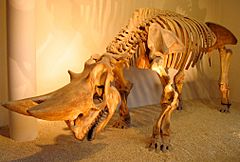Arsinoitherium facts for kids
Quick facts for kids Arsinoitherium |
|
|---|---|
 |
|
| Arsinoitherium zitteli | |
| Scientific classification | |
| Kingdom: | |
| Phylum: | |
| Class: | |
| Superorder: | |
| Order: |
†Embrithopoda
|
| Family: |
†Arsinoitheriidae
|
| Genus: |
†Arsinoitherium
|
| Type species | |
| Arsinoitherium zitteli Beadnell, 1902
|
|
Arsinoitherium was a huge, extinct mammal. It lived a very long time ago, from the late Eocene to the early Oligocene epochs. This means it roamed Earth about 38 to 23 million years ago!
Even though Arsinoitherium looked a lot like a rhinoceros with its two large horns, it was actually more closely related to elephants and manatees. Its fossils have been found in places like Faiyum, Egypt.
Contents
Discovering Arsinoitherium
The first fossils of Arsinoitherium were found in Egypt. Scientists discovered them in an area called the Faiyum Oasis. This region is famous for its many ancient animal fossils.
The most well-known species is Arsinoitherium zitteli. It was named after the ancient Egyptian queen Arsinoe II. The "therium" part of its name means "beast."
What Did Arsinoitherium Look Like?
Arsinoitherium was a very large animal. It stood about 1.75 meters (5.7 feet) tall at the shoulder. It could be up to 3.4 meters (11 feet) long.
- Horns: Its most striking feature was its two massive horns. These horns grew from its nose, not its forehead. They were made of bone, not keratin like rhino horns.
- Body: It had a strong, heavy body. Its legs were thick and pillar-like, similar to an elephant's.
- Skin: Scientists believe it had thick, tough skin. This would have protected it from predators.
Where Did Arsinoitherium Live?
Fossils of Arsinoitherium have been found in several parts of Africa and the Arabian Peninsula. These include:
This shows that Arsinoitherium lived across a wide area. It preferred warm, swampy, and forested environments.
What Did Arsinoitherium Eat?
Scientists think Arsinoitherium was a herbivore. This means it ate plants. Its teeth were well-suited for grinding tough plant material.
It likely fed on soft plants, leaves, and fruits. It probably lived near water, grazing on plants found in swamps and forests.
Why Did Arsinoitherium Go Extinct?
Arsinoitherium disappeared around 23 million years ago. The exact reasons for its extinction are not fully known. However, scientists have some ideas:
- Climate Change: The climate became drier during the Oligocene. This might have changed the types of plants available.
- Habitat Loss: As the climate changed, their swampy habitats may have shrunk.
- Competition: New types of animals might have appeared. These animals could have competed with Arsinoitherium for food and resources.
Images for kids
See also
 In Spanish: Arsinoitherium para niños
In Spanish: Arsinoitherium para niños



